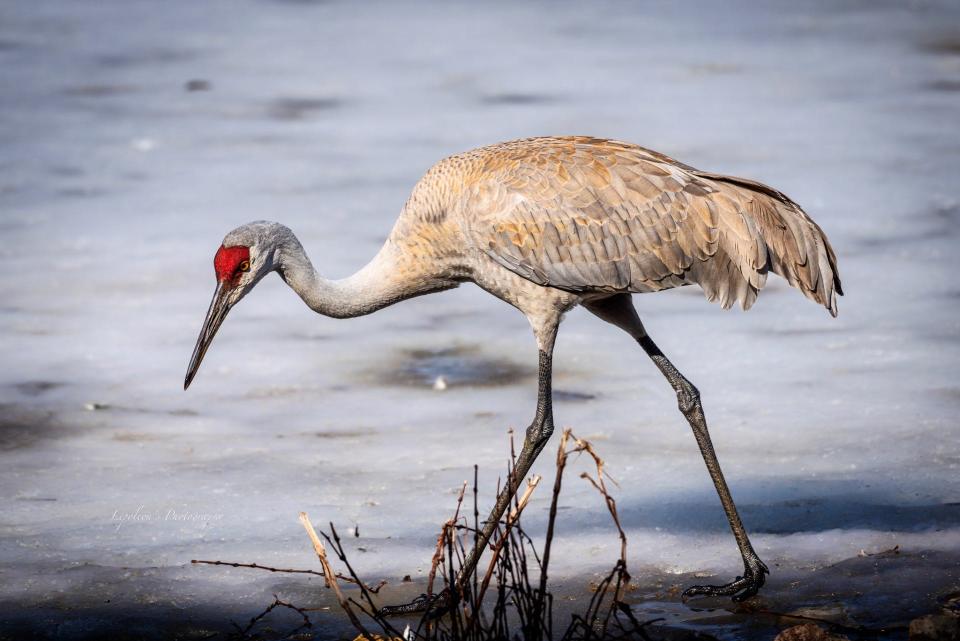Smith: Gone barely a month, migrating birds are making their way back to Wisconsin already
The distinctive, crackling call of sandhill cranes resonated Feb. 12 through the Wisconsin River valley in Sauk County.
It's a sound Andy Radtke, marketing and communications manager of the Aldo Leopold Foundation, knows well and often hears outside his office in Baraboo.
But it still surprised him when he heard it more than two weeks ago. Right place, wrong time.
"We've never had them here this early," Radtke said. "We need to recalibrate our expectations, apparently."
More: Outdoors calendar
Flocks of sandhills gather prior to migration in fall near the Aldo Leopold Foundation headquarters. The birds spend the nights on the sandbars and in shallow water of the Wisconsin River and fly out to forage in fields during day.
Most years the river freezes or snow covers the fields in December and the birds fly south for the winter. Then many return to nest in the Baraboo area in March.

This year the cranes departed Jan. 12 and returned Feb. 12, the "shortest (in days) migration we've ever recorded," Radtke said.
So yes, you can believe your eyes and ears: many migratory birds are returning to Wisconsin earlier than normal this year.
The list includes Canada geese, American robins, turkey vultures, mallard ducks, American woodcock and trumpeter swans.
The winter of 2023-24 brought us record warmth, very little snowfall and very low ice formation. Most meteorologists and other scientists attribute the abnormally warm winter in Wisconsin to an El Niño weather pattern laid atop the long-term trend of climate change.
It just makes sense many bird species are taking advantage of the conditions, said Bill Volkert of Dundee, bird expert and retired Department of Natural Resources naturalist at Horicon Marsh State Wildlife Area.
"I figure we only had eight days of winter, that one storm in January was about it," Volkert said. "It was as mild as I've ever known."
Birds in Wisconsin can be divided into two basic groups: those that migrate in winter and those that stick around.
Species we see all year include the black-capped chickadee, northern cardinal and great-horned owl. The migratory group includes eastern bluebird, barn swallow, wood duck and yellow warbler.
The long-distance migrants fly to the tropics in Central or South America. Those species, most dependent on insects, don't know what the weather is like in Wisconsin, Volkert said. They will wait until instinct tells them to fly north, typically in April or May.
But species that fly just far enough to get out of winter's grip – sandhill cranes or Canada geese, for example – are responding to the early warmth and lack of snow.
More: Six things to know about the Wisconsin state bird, the American robin
These are the birds showing up now.
Sunday evening Troy Drescher of East Troy heard an American woodcock "peenting" on his marsh in Walworth County. It was Drescher's first record of the species this year.
Sandhills are filtering around Wisconsin. Some were photographed Tuesday in Green Bay by Lepoleon Kennedy.
And waterfowl, including trumpeter swans and many species of ducks, are flocking into the state.
On Monday researchers at the Cohen Wildlife Lab at Tennessee Technological University proclaimed "Spring migration has begun!"
As part of its research on waterfowl, the lab attaches GPS tracking devices to waterfowl. Data produced by the work provides detailed histories of the dates and places the birds spend their time during nesting, migration and winter. Over its years of study Cohen determined the average date of "spring migration initiation" is March 15.
But five drake mallards headed north on Monday from their wintering locations in the Mid-South, roughly three weeks earlier than average.
So don't be surprised to see more migratory birds showing up with each passing day. Breeding and nesting will be next on the calendar.
In fact some Wisconsin birds are already in that stage.
Bald eagles have been observed tending eggs on nests in southern Wisconsin, according to Beth Berger Martin, a volunteer with the Southern Wisconsin Bird Alliance's Bald Eagle Nest Watch Program. That's pretty much on schedule, she said.
As for the migratory flocks, Volkert said it's probably wise to keep an open mind about the whens and wheres.
"The one thing I've learned over the decades is to enjoy the wonder of seeing birds," Volkert said. "It doesn't always happen like you expect, but appreciate them all when you can."
More: It's prime eagle-watching time on the upper Mississippi River. Here's how to get the best views.
Estella Leopold dies
Estella Bergere Leopold, the youngest child of Aldo and Estella Leopold, died Sunday at her home in the state of Washington; she was 97.
As she was the last remaining child of the famed conservationist and namesake of the Aldo Leopold Foundation, Estella’s death marks a turning of the page in the Leopold legacy, the foundation said in a statement.
Estella Leopold earned an undergraduate degree from the University of Wisconsin and a doctorate in botany from Yale. She worked for two decades at the U.S. Geological Survey in Denver before becoming director of the Quaternary Research Center at the University of Washington in Seattle. In 1974 she was elected to the National Academy of Sciences and in 2010 she was honored in Osaka, Japan, with the International Cosmos Prize.
A tribute to Estella will be part of the noon Friday kickoff event to Leopold Week, an annual event connecting organized by ALF. More information is available at aldoleopold.org.
This article originally appeared on Milwaukee Journal Sentinel: Migratory birds return to Wisconsin sooner than normal due to weather

